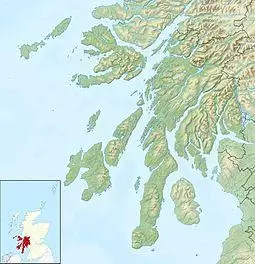| Scottish Gaelic name | Cara |
|---|---|
| Pronunciation | [ˈkʰaɾə] |
| Meaning of name | may be "Kari's island" or "dearest" |
| Location | |
| OS grid reference | NR639440 |
| Coordinates | 55°38′N 5°45′W / 55.63°N 5.75°W |
| Physical geography | |
| Island group | Islay |
| Area | 66 ha (1&fras1;4 sq mi) |
| Area rank | 178= [1] |
| Highest elevation | 56 m (184 ft) |
| Administration | |
| Sovereign state | United Kingdom |
| Country | Scotland |
| Council area | Argyll and Bute |
| Demographics | |
| Population | 0 |
| References | [2][3][4][5] |
Cara Island (Scottish Gaelic: Cara) is a small island which is located off the west coast of Kintyre in Scotland.
Geography and etymology
Cara is 1 kilometre (5&fras1;8 mi) south of Gigha. It is accessible from Gigha.
Cara has a translation in Gaelic as "dearest" or "dear one". Cara is a popular girl's name in the local area and in Scotland in general.
History

In 1881 a commercial vessel, the Henrietta from Brixham, foundered and sank off the Cara Island coast. Her captain drowned after falling overboard during the incident; his body ultimately washed ashore on the distant Pentland Skerries. The remainder of the crew reached Cara Island unharmed.[6]
Cara is currently owned by MacDonald Lockhart of Kintyre and is reputed to be the only island still in the possession of a direct descendant of the Lords of the Isles. The only habitable building on the island is Cara House, but that is derelict[7]
The liner Aska was sunk on 22 September 1940 on rocks northwest of the island after being struck by German bombers.
Wildlife
Cara is well known for a herd of feral goats, which still thrive on the wild landscape.
Mythology
Cara is famous as the home of the Uruisg/broonie, the familiar spirit of the Macdonald of Largie family. A rock formation known as the Broonie's Chair is found at the extreme southern tip of the island.
References
- ^
- ^ 2001 UK Census per List of islands of Scotland
- ^ Haswell-Smith, Hamish (2004). The Scottish Islands. Edinburgh: Canongate. ISBN 978-1-84195-454-7.
- ^ Get-a-map (Map). Ordnance Survey.
- ^ Anderson, Joseph (Ed.) (1893) Orkneyinga Saga. Translated by Jón A. Hjaltalin & Gilbert Goudie. Edinburgh. James Thin and Mercat Press (1990 reprint). ISBN 0-901824-25-9
- ^ "Casualties". Western Daily Mercury. Plymouth, UK: Isaac Latimer and Son. 9 March 1881. Retrieved 27 September 2016.
- ^ "Cara House, Isle of Gigha". britishlistedbuildings.co.uk. Retrieved 27 September 2016.
External links


